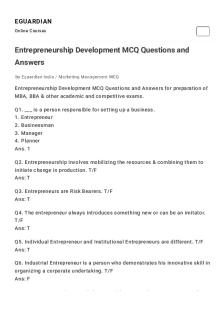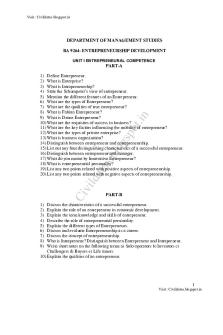ENTREPRENEURSHIP DEVELOPMENT PDF

| Title | ENTREPRENEURSHIP DEVELOPMENT |
|---|---|
| Pages | 71 |
| File Size | 90.4 MB |
| File Type | |
| Total Downloads | 50 |
| Total Views | 267 |
Summary
ARYA SCHOOL OF MANAGEMENT & IT, BHUBANESWAR ENTREPRENEURSHIP DEVELOPMENT, BBA- 6th SEM ENTREPRENEURSHIP DEVELOPMENT COURSE BBA Semester VI Prepared by: MR. RASHMIRANJAN PANIGRAHI Assistant Professor, Finance & Marketing Department of Management MR. Amitava Pani Assistant Professor, Managemen...
Description
Accelerat ing t he world's research.
ENTREPRENEURSHIP DEVELOPMENT Rashmi Ranjan Panigrahi
Related papers
Download a PDF Pack of t he best relat ed papers
Ent repreneurship Development and challenges faced by Ent repreneurs in MSME sect or: A st … Int ernat ional Research Journal Commerce art s science Opport unit ies and Challenges of Women Ent repreneurs in Urban Set -Up: A Case St udy in t he Cit y Of B… IOSR Journals Role of Financial Inst it ut ions for t he Development of Women Ent repreneurship in India kousalya Devi
ARYA SCHOOL OF MANAGEMENT & IT, BHUBANESWAR ENTREPRENEURSHIP DEVELOPMENT, BBA- 6th SEM
ENTREPRENEURSHIP DEVELOPMENT
COURSE BBA Semester VI Prepared by:
MR. RASHMIRANJAN PANIGRAHI Assistant Professor, Finance & Marketing Department of Management
MR. Amitava Pani Assistant Professor, Management Department of Management & Computer Sc.
UTKAL UNIVERSITY, BHUBANESWAR, ODISHA
Page 1
ARYA SCHOOL OF MANAGEMENT & IT, BHUBANESWAR ENTREPRENEURSHIP DEVELOPMENT, BBA- 6th SEM
ENTREPRENEURSHIP DEVELOPMENT UTKAL UNIVERSITY, BHUBANESWAR
Semester VI
Unit – I Entrepreneurship General Concept: definition, entrepreneurial culture, theory of Entrepreneurship, types of entrepreneurship, entrepreneurial trade and motivation entrepreneur and professional manager. Unit – II Environment and Entrepreneurial Development: Entrepreneurial Development, Process of Entrepreneurial Development, training of entrepreneur, institutions, producing aids for an Entrepreneurial Development. Unit – III Project Appraisal and Management: Search for business ideas, project Identification and formulation, project appraisal, profitability and risk analysis , sources of finance, role of consultancy organization Unit – IV Legal and Statutory Environment in setting of a Small Industry : Basics of Tactandes Act, labour laws, Governmental setup in promoting small industries, financial institution, export – import rules. Unit – V Location of an enterprise, factor design and layout, setting quality standards steps in starting a small industry, incentives and subsidies, problems in small enterprise management, sickness and preventions.
Page 2
ARYA SCHOOL OF MANAGEMENT & IT, BHUBANESWAR ENTREPRENEURSHIP DEVELOPMENT, BBA- 6th SEM
TABLE OF CONTENT Topics Covered
SL No.
1
2
3
4
5
Entrepreneurship General Concept: definition, entrepreneurial culture, theory of Entrepreneurship, types Unit -I of entrepreneurship, entrepreneurial trade and motivation entrepreneur and professional manager. Probable Questions Environment and Entrepreneurial Development: Entrepreneurial Development,Process of Entrepreneurial Unit -I Development, training of entrepreneur, institutions, producing aids for an Entrepreneurial Development. Probable Questions
Unit III
Project Appraisal and Management: Search for business ideas, project Identification and formulation, project appraisal, profitability and risk analysis , sources of finance, role of consultancy organization Probable Questions
Unit VI
Legal and Statutory Environment in setting of a Small Industry : Basics of Tactandes Act, labour laws, Governmental setup in promoting small industries, financial institution, export – import rules. Probable Questions
Unit V
Location of an enterprise, factor design and layout, setting quality standards steps in starting a small industry, incentives and subsidies, problems in small enterprise management, sickness and preventions. Probable Questions
4 - 23
24 - 34
35-47
48-60
61-70
Page 3
ARYA SCHOOL OF MANAGEMENT & IT, BHUBANESWAR ENTREPRENEURSHIP DEVELOPMENT, BBA- 6th SEM
ENTREPRENEURSHIP DEVELOPMENT Unit – I Entrepreneurship General Concept: definition, entrepreneurial culture, theory of Entrepreneurship, types of entrepreneurship, entrepreneurial trait and Motivation entrepreneur and professional manager. The word ‘entrepreneur’ is derived from French word ‘Entreprendre’ means to undertake certain activities. Generally, any person starting a new project or trying a new opportunity. An entrepreneur is an individual who accepts financial risks and undertakes new financial ventures. ¨Some one who initiates and actively operates an entrepreneurial venture. 1.1 DEFINITIONS OF ENTREPRENEUR 1. According to Gilbraith: “An entrepreneur must accept the challenge and should be willing hard to achieve something”. 2. Peter F. Drucker defines an entrepreneur as one who always searches for change, responds to it and exploits it as an opportunity. Innovation is the basic tool of entrepreneurs, the means by which they exploit change as an opportunity for a different business or service. 3. According to Frank Young defined entrepreneur as a change agent. 4. According to Max Weber: “Entrepreneurs are a product of particular social condition in which they are brought up and it is the society which shapes individuals as entrepreneurs”. 5. International Labour Organization (ILO) defines entrepreneurs as those people who have the ability to see and evaluate business opportunities, together with the necessary resources to take advantage of them and to initiate appropriate action to ensure success.
6. According to Cantillon “An entrepreneur is a person who buys factor services at certain prices with a view to selling its product at uncertain prices”.
Page 4
ARYA SCHOOL OF MANAGEMENT & IT, BHUBANESWAR ENTREPRENEURSHIP DEVELOPMENT, BBA- 6th SEM
1.2 CONCEPT OF ENTREPRENEUR As said above entrepreneur is used in various ways and various views. These views are broadly classified into three groups, namely risk bearer, organizer and innovator. 1. Entrepreneur as risk bearer: Richard Cantilon defined entrepreneur as an agent who buys factors as production at certain prices in order to combine them into a product with a view to selling it at uncertain prices in future. He illustrated a former who pays contractual incomes, which are certain to land owners and laborers, and sells at prices that are ‘uncertain’. He includes merchants also who make certain payments in expectation of uncertain receipts. Hence both of them are risk-bearing agents of production. P.H. Knight described entrepreneur to be a specialized group of persons who bear uncertainty. Uncertainty is defined as risk, which cannot be insured against and is incalculable. He made distinction between certainty and risk. A risk can be reduced through the insurance principle, where the distribution of outcome in a group of instance is known, whereas uncertainty cannot be calculated. 2. Entrepreneur as an organizer: According to J Baptist Say “an entrepreneur is one who combines the land of one, the labor of another and capital of yet another, and thus produces a product. By selling the product in the market, he pays interest on capital, rent on land and wages to laborers and what remains is his/her profit”. Say made distinction between the role of capitalist as a financer and the entrepreneur as an organizer. This concept of entrepreneur is associated with the functions of coordination, organization and supervision. 3. Entrepreneur as an innovator: Joseph A SchumPeter in 1934 assigned a crucial role of ‘innovation’ to the entrepreneur. He considered economic development as a dynamic change brought by entrepreneur by instituting new combinations of factors of production, i.e. innovations. The introduction of new combination according to him, may occur in any of the following forms. a) Introduction of new product in the market. b) Use of new method of production, which is not yet tested. c) Opening of new market.
Page 5
ARYA SCHOOL OF MANAGEMENT & IT, BHUBANESWAR ENTREPRENEURSHIP DEVELOPMENT, BBA- 6th SEM
d) Discovery of new source of raw materials. e) Bringing out of new form of organization.
SchumPeter also made distinction between inventor and innovator. An inventor is one who discovers new methods and new materials. An innovator utilizes inventions and discovers in order to make new combinations.
Hence the concept of entrepreneur is associated with three elements riskbearing, organizing and innovating. Hence “an entrepreneur can be defined as a person who tries to create something new, organizes production and undertakes risks and handles economic uncertainty involved in enterprise.”
1.3 QUALITIES / SKILLS OF AN ENTREPRENEUR To be a successful and ideal entrepreneur, one should have certain qualities or skills as given below:Ability to organize: He should be able to organize various factors effectively. He has to understand all the aspects of the business. Professional approach: He should be objective and professional in approach. Risk bearer: He should be risk taker. He should be ready to bear risk and uncertainties. Innovative: Organizer should be innovative. He should adopt modern techniques of production. He should not be reluctant to changes. Decision Making: One has to take right decision at a right time by showing his promptness. Quick decisions are expected but hasty decisions shouldn't be taken. Delay in decisions may increase cost of project and reduce the profits. Negotiation skills: Businessman regularly comes into contact with various persons like consumers, workers, government officials, etc. so he should communicate tactfully
1.4 CHARACTERISTICS/ TRAIT OF ENTREPRENEURSHIP:
Page 6
ARYA SCHOOL OF MANAGEMENT & IT, BHUBANESWAR ENTREPRENEURSHIP DEVELOPMENT, BBA- 6th SEM
Entrepreneur is a person of telescopic faculty drive and talent who perceives business opportunities and promptly seizes them for exploitation. Entrepreneur needs to possess competencies to perform entrepreneur activities. Table 1 gives core competencies. 1. Economic and dynamic activity: Entrepreneurship is an economic activity because it involves the creation and operation of an enterprise with a view to creating value or wealth by ensuring optimum utilisation of scarce resources. Since this value creation activity is performed continuously in the midst of uncertain business environment, therefore, entrepreneurship is regarded as a dynamic force. 2. Related to innovation: Entrepreneurship involves a continuous search for new ideas. Entrepreneurship compels an individual to continuously evaluate the existing modes of business operations so that more efficient and effective systems can be evolved and adopted. In other words, entrepreneurship is a continuous effort for synergy (optimization of performance) in organizations. 3. Profit potential: “Profit potential is the likely level of return or compensation to the entrepreneur for taking on the risk of developing an idea into an actual business venture.” Without profit potential, the efforts of entrepreneurs would remain only an abstract and a theoretical leisure activity. 4. Risk bearing: The essence of entrepreneurship is the ‘willingness to assume risk’ arising out of the creation and implementation of new ideas. New ideas are always tentative and their results may not be instantaneous and positive. An entrepreneur has to have patience to see his efforts bear fruit. In the intervening period (time gap between the conception and implementation of an idea and its results), an entrepreneur has to assume risk. If an entrepreneur does not have the willingness to assume risk, entrepreneurship would never succeed. TRAIT OF ENTREPRENEURSHIP
Page 7
ARYA SCHOOL OF MANAGEMENT & IT, BHUBANESWAR ENTREPRENEURSHIP DEVELOPMENT, BBA- 6th SEM
(Table 1)
Page 8
ARYA SCHOOL OF MANAGEMENT & IT, BHUBANESWAR ENTREPRENEURSHIP DEVELOPMENT, BBA- 6th SEM
1.5 ENTREPRENEURIAL PROCESS: Entrepreneurship is a process, a journey, not the destination; a means, not an end. All the successful entrepreneurs like Bill Gates (Microsoft), Warren Buffet (Hathaway), Gordon Moore (Intel) Steve Jobs (Apple Computers), Jack Welch (GE) GD Birla, Jamshedji Tata and others all went through this process. To establish and run an enterprise it is divided into three parts – the entrepreneurial job, the promotion, and the operation. Entrepreneurial job is restricted to two steps, i.e., generation of an idea and preparation of feasibility report. In this chapter, we shall restrict ourselves to only these two aspects of entrepreneurial process.
The Entrepreneurial Process 1. Idea Generation: To generate an idea, the entrepreneurial process has to pass through three stages: a. Germination: This is like seeding process, not like planting seed. It is more like the natural seeding. Most creative ideas can be linked to an individual’s interest or curiosity about a specific problem or area of study. b. Preparation: Once the seed of interest curiosity has taken the shape of a focused idea, creative people start a search for answers to the problems. Inventors will go on for setting up laboratories; designers will think of engineering new product ideas and marketers will study consumer buying habits. c. Incubation: This is a stage where the entrepreneurial process enters the subconscious intellectualization. The sub-conscious mind joins the unrelated ideas so as to find a resolution.
Page 9
ARYA SCHOOL OF MANAGEMENT & IT, BHUBANESWAR ENTREPRENEURSHIP DEVELOPMENT, BBA- 6th SEM
2. Feasibility study: Feasibility study is done to see if the idea can be commercially viable. It passes through two steps: a. Illumination: After the generation of idea, this is the stage when the idea is thought of as a realistic creation. The stage of idea blossoming is critical because ideas by themselves have no meaning. b. Verification: This is the last thing to verify the idea as realistic and useful for application. Verification is concerned about practicality to implement an idea and explore its usefulness to the society and the entrepreneur. 1.6 IMPORTANCE OF ENTREPRENEURSHIP: Entrepreneurship offers the following benefits: Benefits of Entrepreneurship to an Organization: 1
Development of managerial capabilities:
The biggest significance of entrepreneurship lies in the fact that it helps in identifying and developing managerial capabilities of entrepreneurs. An entrepreneur studies a problem, identifies its alternatives, compares the alternatives in terms of cost and benefits implications, and finally chooses the best alternative. This exercise helps in sharpening the decision making skills of an entrepreneur. Besides, these managerial capabilities are used by entrepreneurs in creating new technologies and products in place of older technologies and products resulting in higher performance.
2
Creation of organizations:
Entrepreneurship results into creation of organisations when entrepreneurs assemble and coordinate physical, human and financial resources and direct them towards achievement of objectives through managerial skills. 3. Improving standards of living: By creating productive organisations, entrepreneurship helps in making a wide variety of goods and services available to the society which results into higher standards of living for the people.
Page 10
ARYA SCHOOL OF MANAGEMENT & IT, BHUBANESWAR ENTREPRENEURSHIP DEVELOPMENT, BBA- 6th SEM
Possession of luxury cars, computers, mobile phones, rapid growth of shopping malls, etc. are pointers to the rising living standards of people, and all this is due to the efforts of entrepreneurs 4. Means of economic development: Entrepreneurship involves creation and use of innovative ideas, maximization of output from given resources, development of managerial skills, etc., and all these factors are so essential for the economic development of a country.
1.7 TYPES OF ENTREPRENEURS: Depending upon the level of willingness to create innovative ideas, there can be the following types of entrepreneurs: 1. Innovative entrepreneurs: These entrepreneurs have the ability to think newer, better and more economical ideas of business organization and management. They are the business leaders and contributors to the economic development of a country. Inventions like the introduction of a small car ‘Nano’ by Ratan Tata, organised retailing by Kishore Biyani, making mobile phones available to the common may by Anil Ambani are the works of innovative entrepreneurs. 2. Imitating entrepreneurs: These entrepreneurs are people who follow the path shown by innovative entrepreneurs. They imitate innovative entrepreneurs because the environment in which they operate is such that it does not permit them to have creative and innovative ideas on their own. Such entrepreneurs are found in countries and situations marked with weak industrial and institutional base which creates difficulties in initiating innovative ideas. In our country also, a large number of such entrepreneurs are found in every field of business activity and they fulfill their need for achievement by imitating the ideas introduced by innovative entrepreneurs. Development of small shopping complexes is the work of imitating entrepreneurs. All the small car manufacturers now are the imitating entrepreneurs. 3. Fabian entrepreneurs: The dictionary meaning of the term ‘fabian’ is ‘a person seeking victory by delay rather than by a decisive battle’. Fabian entrepreneurs are those individuals who do not show initiative in visualising and implementing new ideas and innovations wait for some development which would motivate them to initiate unless there is an imminent threat to their very existence.
Page 11
ARYA SCHOOL OF MANAGEMENT & IT, BHUBANESWAR ENTREPRENEURSHIP DEVELOPMENT, BBA- 6th SEM
4. Drone entrepreneurs: The dictionary meaning of the term ‘drone’ is ‘a person who lives on the labor of others’. Drone entrepreneurs are those individuals who are satisfied with the existing mode and speed of business activity and show no inclination in gaining market leadership. In other words, drone entrepreneurs are die-hard conservatives and even ready to suffer the loss of business. 5. Social Entrepreneur: Social entrepreneurs drive social innovation and transformation in various fields including education, health, human rights, workers’ rights, environment and enterprise development. They undertake poverty alleviation objectives with the zeal of an entrepreneur, business practices and dare to overcome traditional practices and to innovate. Dr Mohammed Yunus of Bangladesh who started Gramin Bank is a case of social entrepreneur. 1.8 FUNCTIONS OF AN ENTREPRENEUR The important functions performed by an entrepreneur are listed below: An Entrepreneur has to perform a number of functions right from the generation of idea up to the establishment of an enterprise. He also has to perform functions for successful running of his enterprise. Entrepreneur has to perceive business opportunities and mobilize resources like man, money, machines, materials and methods. The following are the main functions of an Entrepreneur. 1. Idea generation: The first and the most important function of an Entrepreneur is idea generation. Idea generation implies product selection and project identification. Idea generation is possible through vision, insight, keen observation, education, experience and exposure. This needs scanning of business environment and market survey. 2. Determination of business objectives: Entrepreneur has to state and lay down the business objectives. Objectives should be spelt out in clear terms. The Entrepreneur must be clear about the nature and type of business, i.e. whether manufacturing concern or service oriented unit or a trading business so that he can very well carry on the venture in accordance with the objectives determined by him. 3. Rising of funds: All the activities of the business depend upon the finance and hence fund rising is a...
Similar Free PDFs

Entrepreneurship-Development
- 15 Pages

ENTREPRENEURSHIP DEVELOPMENT
- 71 Pages

MBA 207 Entrepreneurship Development
- 12 Pages
Popular Institutions
- Tinajero National High School - Annex
- Politeknik Caltex Riau
- Yokohama City University
- SGT University
- University of Al-Qadisiyah
- Divine Word College of Vigan
- Techniek College Rotterdam
- Universidade de Santiago
- Universiti Teknologi MARA Cawangan Johor Kampus Pasir Gudang
- Poltekkes Kemenkes Yogyakarta
- Baguio City National High School
- Colegio san marcos
- preparatoria uno
- Centro de Bachillerato Tecnológico Industrial y de Servicios No. 107
- Dalian Maritime University
- Quang Trung Secondary School
- Colegio Tecnológico en Informática
- Corporación Regional de Educación Superior
- Grupo CEDVA
- Dar Al Uloom University
- Centro de Estudios Preuniversitarios de la Universidad Nacional de Ingeniería
- 上智大学
- Aakash International School, Nuna Majara
- San Felipe Neri Catholic School
- Kang Chiao International School - New Taipei City
- Misamis Occidental National High School
- Institución Educativa Escuela Normal Juan Ladrilleros
- Kolehiyo ng Pantukan
- Batanes State College
- Instituto Continental
- Sekolah Menengah Kejuruan Kesehatan Kaltara (Tarakan)
- Colegio de La Inmaculada Concepcion - Cebu












